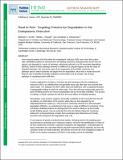Road to Ruin: Targeting Proteins for Degradation in the Endoplasmic Reticulum
Author(s)
Ploegh, Hidde; Smith, Melanie H.; Weissman, Jonathan S.
Downloadnihms-522926.pdf (4.522Mb)
OPEN_ACCESS_POLICY
Open Access Policy
Creative Commons Attribution-Noncommercial-Share Alike
Terms of use
Metadata
Show full item recordAbstract
Some nascent proteins that fold within the endoplasmic reticulum (ER) never reach their native state. Misfolded proteins are removed from the folding machinery, dislocated from the ER into the cytosol, and degraded in a series of pathways collectively referred to as ER-associated degradation (ERAD). Distinct ERAD pathways centered on different E3 ubiquitin ligases survey the range of potential substrates. We now know many of the components of the ERAD machinery and pathways used to detect substrates and target them for degradation. Much less is known about the features used to identify terminally misfolded conformations and the broader role of these pathways in regulating protein half-lives.
Date issued
2011-11Department
Massachusetts Institute of Technology. Department of Biology; Whitehead Institute for Biomedical ResearchJournal
Science
Publisher
American Association for the Advancement of Science (AAAS)
Citation
Smith, M. H., H. L. Ploegh, and J. S. Weissman. “Road to Ruin: Targeting Proteins for Degradation in the Endoplasmic Reticulum.” Science 334, no. 6059 (November 25, 2011): 1086–1090.
Version: Author's final manuscript
ISSN
0036-8075
1095-9203